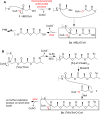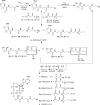Trapping of intermediates with substrate analog HBOCoA in the polymerizations catalyzed by class III polyhydroxybutyrate (PHB) synthase from Allochromatium vinosum
- PMID: 25686368
- PMCID: PMC4870837
- DOI: 10.1021/cb5009958
Trapping of intermediates with substrate analog HBOCoA in the polymerizations catalyzed by class III polyhydroxybutyrate (PHB) synthase from Allochromatium vinosum
Abstract
Polyhydroxybutyrate (PHB) synthases (PhaCs) catalyze the formation of biodegradable PHB polymers that are considered as an ideal alternative to petroleum-based plastics. To provide strong evidence for the preferred mechanistic model involving covalent and noncovalent intermediates, a substrate analog HBOCoA was synthesized chemoenzymatically. Substitution of sulfur in the native substrate HBCoA with an oxygen in HBOCoA enabled detection of (HB)nOCoA (n = 2-6) intermediates when the polymerization was catalyzed by wild-type (wt-)PhaECAv at 5.84 h(-1). This extremely slow rate is due to thermodynamically unfavorable steps that involve the formation of enzyme-bound PHB species (thioesters) from corresponding CoA oxoesters. Synthesized standards (HB)nOCoA (n = 2-3) were found to undergo both reacylation and hydrolysis catalyzed by the synthase. Distribution of the hydrolysis products highlights the importance of the penultimate ester group as previously suggested. Importantly, the reaction between primed synthase [(3)H]-sT-PhaECAv and HBOCoA yielded [(3)H]-sTet-O-CoA at a rate constant faster than 17.4 s(-1), which represents the first example that a substrate analog undergoes PHB chain elongation at a rate close to that of the native substrate (65.0 s(-1)). Therefore, for the first time with a wt-synthase, strong evidence was obtained to support our favored PHB chain elongation model.
Figures









Similar articles
-
Detection of covalent and noncovalent intermediates in the polymerization reaction catalyzed by a C149S class III polyhydroxybutyrate synthase.Biochemistry. 2009 Oct 6;48(39):9202-11. doi: 10.1021/bi901329b. Biochemistry. 2009. PMID: 19711985 Free PMC article.
-
Detection of intermediates from the polymerization reaction catalyzed by a D302A mutant of class III polyhydroxyalkanoate (PHA) synthase.Biochemistry. 2005 Feb 8;44(5):1495-503. doi: 10.1021/bi047734z. Biochemistry. 2005. PMID: 15683234
-
Class III polyhydroxybutyrate synthase: involvement in chain termination and reinitiation.Biochemistry. 2005 Jun 14;44(23):8369-77. doi: 10.1021/bi050331u. Biochemistry. 2005. PMID: 15938626
-
In vitro analysis of the chain termination reaction in the synthesis of poly-(R)-beta-hydroxybutyrate by the class III synthase from Allochromatium vinosum.Biomacromolecules. 2005 Jul-Aug;6(4):2113-9. doi: 10.1021/bm0501048. Biomacromolecules. 2005. PMID: 16004452
-
PHA synthase engineering toward superbiocatalysts for custom-made biopolymers.Appl Microbiol Biotechnol. 2007 Jan;73(5):969-79. doi: 10.1007/s00253-006-0566-4. Epub 2006 Nov 23. Appl Microbiol Biotechnol. 2007. PMID: 17123079 Review.
Cited by
-
Role of PhaC Type I and Type II Enzymes during PHA Biosynthesis.Polymers (Basel). 2018 Aug 13;10(8):910. doi: 10.3390/polym10080910. Polymers (Basel). 2018. PMID: 30960835 Free PMC article. Review.
-
Structure of the Catalytic Domain of the Class I Polyhydroxybutyrate Synthase from Cupriavidus necator.J Biol Chem. 2016 Nov 25;291(48):25264-25277. doi: 10.1074/jbc.M116.756833. Epub 2016 Oct 14. J Biol Chem. 2016. PMID: 27742839 Free PMC article.
-
Structures of Polyhydroxyalkanoate Synthase PhaC from Aeromonas caviae, Producing Biodegradable Plastics.Angew Chem Int Ed Engl. 2025 Jun 24;64(26):e202504626. doi: 10.1002/anie.202504626. Epub 2025 May 6. Angew Chem Int Ed Engl. 2025. PMID: 40276819 Free PMC article.
-
Study of Class I and Class III Polyhydroxyalkanoate (PHA) Synthases with Substrates Containing a Modified Side Chain.Biomacromolecules. 2016 Apr 11;17(4):1477-85. doi: 10.1021/acs.biomac.6b00082. Epub 2016 Mar 22. Biomacromolecules. 2016. PMID: 26974339 Free PMC article.
References
-
- Chee JY, Yoga SS, Lau NS, Ling SC, Abed RMM, Sudesh K. Bacterially produced polyhydroxyalkanoate (PHA): Converting renewable resources into bioplastics. Vol. 1. Formatex Research Center; Spain: 2010.
-
- Chen GQ. Plastics from bacteria: Natural functions and applications. Springer; Heidelberg ; New York: 2010.
-
- Verlinden RAJ, Hill DJ, Kenward MA, Williams CD, Radecka I. Bacterial synthesis of biodegradable polyhydroxyalkanoates. J. Appl. Microbiol. 2007;102:1437–1449. - PubMed
-
- Sudesh K, Abe H, Doi Y. Synthesis, structure and properties of polyhydroxyalkanoates: biological polyesters. Prog. Polym. Sci. 2000;25:1503–1555.
Publication types
MeSH terms
Substances
Grants and funding
LinkOut - more resources
Full Text Sources
Other Literature Sources

